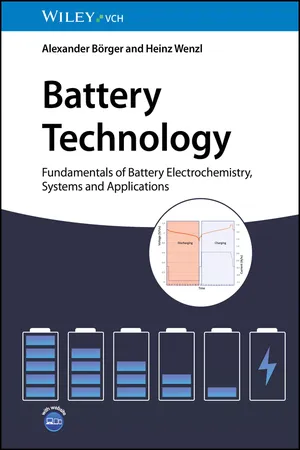
Battery Technology
Fundamentals of Battery Electrochemistry, Systems and Applications
- 563 pages
- English
- PDF
- Available on iOS & Android
Battery Technology
Fundamentals of Battery Electrochemistry, Systems and Applications
About this book
Understand the technology that will power our future with this comprehensive guide
Energy supply is perhaps the most challenging engineering problem and social and economic issue of the modern age. Energy storage technologies and in particular batteries are an important option to optimize energy supply systems both technically and economically. They help to drive down costs, make new products and services possible and can reduce emissions. Batteries are now key components for vehicles, portable products and the electricity supply system. Understanding batteries, in particular the two dominant battery technologies, lead-acid and lithium-ion, has therefore never been more essential to technological developments for these applications.
Battery Technology: Fundamentals of Battery Electrochemistry, Systems and Applications offers a comprehensive overview of how batteries work, why they are designed the way they are, the technically and economically most important systems and their applications. The book begins with background information on the electrochemistry, the structure of the materials and components and the properties of batteries. The book then moves to practical examples often using field data of battery usage. It can serve both as an introduction for engineering and science students and as a guide for those developing batteries and integrating batteries into energy systems.
Battery Technology readers will also find:
- A focused introduction to electrochemical and materials science aspects of battery research
- An author team with decades of combined experience in battery research and industry
- Clear structure enabling easy use
Battery Technology is ideal for materials scientists, software engineers developing battery management systems, design engineers for batteries, battery systems and the many auxiliary components required for safe and reliable operation of batteries.
Frequently asked questions
- Essential is ideal for learners and professionals who enjoy exploring a wide range of subjects. Access the Essential Library with 800,000+ trusted titles and best-sellers across business, personal growth, and the humanities. Includes unlimited reading time and Standard Read Aloud voice.
- Complete: Perfect for advanced learners and researchers needing full, unrestricted access. Unlock 1.4M+ books across hundreds of subjects, including academic and specialized titles. The Complete Plan also includes advanced features like Premium Read Aloud and Research Assistant.
Please note we cannot support devices running on iOS 13 and Android 7 or earlier. Learn more about using the app.
Information
Table of contents
- Cover
- Title Page
- Copyright
- Contents
- Preamble
- Abbreviations
- About the Companion Website
- Chapter 1 Introduction
- Chapter 2 Electrochemical Basics
- Chapter 3 Charging and Discharging Cells and Batteries
- Chapter 4 Structure of Electrodes, Design of Cells, and Complete Battery Systems
- Chapter 5 Thermal Properties of Cells and Batteries
- Chapter 6 Ageing Processes and Service Life of Batteries and Cells
- Chapter 7 State of X Definitions and Calculations
- Chapter 8 Battery Models
- Chapter 9 Determination of Parameters
- Chapter 10 Battery Diagnostics and Analytics
- Chapter 11 Overview of Battery Systems
- Chapter 12 Lead–Acid Batteries
- Chapter 13 Lithium‐Ion Batteries
- Chapter 14 Other Battery Technologies
- Chapter 15 Overview of Applications
- Chapter 16 Starter Batteries for Vehicles (Starting, Lighting, Ignition — SLI)
- Chapter 17 Batteries for Electromobility
- Chapter 18 Traction Batteries for Material Handling
- Chapter 19 Stationary Applications of Batteries
- Chapter 20 Batteries for Portable Applications
- Appendix A Overview of Terms
- Appendix B Safe and Environmentally Friendly Handling of Batteries
- Appendix C Overview of Standards
- Appendix D Electrochemical Impedance Spectroscopy (EIS)
- Appendix E Acid Stratification
- References
- Index
- EULA